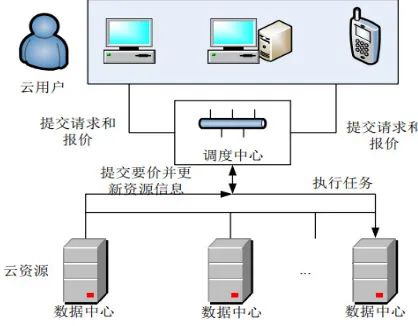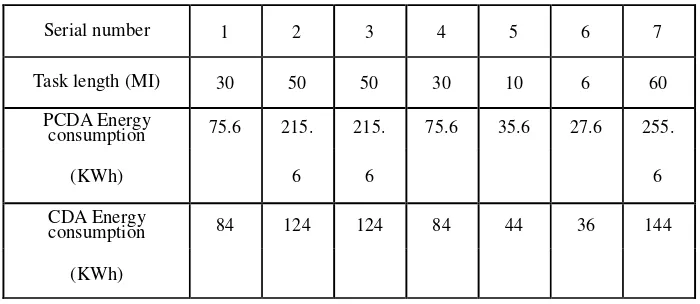2019 International Conference on Artificial Intelligence and Computing Science (ICAICS 2019) ISBN: 978-1-60595-615-2
Research Resource Scheduling Scheme Based on Joint Bidding
Lian GUO
1and Wang HE
2,*1State Grid Xinyi City Power Supply Company, China
2School of Computer Science and Technology, China University of Mining and Technology, China
*Corresponding author
Keywords: Two-way auction, Resource scheduling, Flexible distribution.
Abstract. A resource scheduling scheme based on combined bidirectional auction is proposed for resource scheduling across data centers. Based on the definition of user priority and task urgency, the scheme estimates the SLA(service level agreement) violation occurred in each work during the auction process and calculates the income of the cloud provider. Simulation results show that this algorithm ensures the success rate of auction, and compared with the traditional combined bidirectional auction scheme in which a single auction is completed, the energy consumption reduction of this scheme in the auction period and the profit of the auction cloud provider are greatly optimized.
Introduction
The classic cloud computing service system can be divided into three layers: Infrastructure-as-a-Service (IaaS), Platform-as-a-Infrastructure-as-a-Service (PaaS), and Software-as-Software-as- a-Infrastructure-as-a-Service, SaaS)[1]. By using the PaaS model, customers can focus on code without regard to factors such as maintenance costs and operating systems. During the auction process, the Service-Level Agreement (SLA) violations for each job are estimated and the cloud provider's revenue is calculated, and each round of auction allows multiple transactions to be completed.
Related Work
In order to solve the problem of resource scheduling across data centers, some existing methods perform resource scheduling through a two-way auction mechanism. In this respect, Sun Jiajia et al
[4] proposed an intelligent resource allocation mechanism based on two-way auction, introduced the
group search optimization algorithm into the resource allocation mechanism. He et al. [5] transformed
the minimum energy cost problem of data center resource scheduling into constrained stochastic optimization problem. Then, based on the two-way auction mechanism, an online control algorithm was designed to reduce the energy of the data center by using Lyapunov optimization technique. Consumption. There is also a mechanism for combining resources for auction. In this regard, Zhao et al. [6] proposed a combined two-way auction mechanism, in which different types of virtual machines
are bundled together for auction. Quote and increase the probability of winning the next round of bidding. Huu et al. [7] proposed a new resource scheduling model, using a combined two-way auction
mechanism and considering energy consumption parameters.
Problem Statement and System Model
Questions Raised
Based on the above problems, this paper proposes a resource scheduling scheme based on combined two-way auction, which defines the user priority and considers the penalty caused by the SLA violation in the winner's determination problem, and increases the number of transactions per round of auction.
Resource Auction Model Based on Combined Two-Way Auction
[image:2.612.111.503.207.317.2]As shown in Figure 1, the cloud resource market framework is mainly composed of cloud users and their agents, cloud providers and their agents, and cloud market managers [12]. The cloud user agent helps the user complete the transaction, and at the same time, the cloud provider submits the resource information to the cloud market manager through the cloud provider agent.
Figure 1. Cloud resource market architecture.
Figure 2 shows a resource auction model based on two-way auctions. If there is a new task requirement, the user needs to re-participate in the auction to obtain new resources.
Figure 2. Resource auction model based on two-way auction.
The user can give the quotation through the user agent for the two types of resources, A and B. The cloud provider agent obtains the user request information from the auction market and targets both A and B. The bundled resource bundle is used for the asking price, and the two parties complete the transaction through the auction agent.
The Overall Idea
[image:2.612.203.412.375.538.2]than the cloud resource asking price Match the minimum asking price of the cloud resource provider and continue in order until the above conditions are not met.
Cloud Resource Scheduling Scheme Based on Combined Two-Way Auction
Cloud User and Agent Quote
The cloud provider submits the resource status information of its own data center to the cloud provider agent, and the agent gives the price of the resource according to the information submitted by the agent and the resource information required by the user obtained from the cloud market management. Unlike most existing methods [14-16], the asking price of cloud providers in this paper is related to the
resource utilization of the current data center, realizing the dynamic adjustment of prices.
Cloud Provider and Its Agent Asking Price
The auction agent is responsible for obtaining the quotation and asking price information of the resource from the cloud user agent and the cloud provider agent, and after sorting all the quotations and asking prices, generating a quotation list and a list of asking prices for each bundled resource. In this auction algorithm, multiple users and multiple cloud providers submit their respective prices for multiple resources or resource combinations, allowing multiple transactions to be traded in one auction.
Energy Analysis of Cloud Resource Scheduling Method
In today's global energy shortage, when studying resource scheduling in the cloud market, energy consumption should be an important factor in resource scheduling. UsePidle to indicate the energy
consumption per unit time of the idle state server node, Pmax represents the energy consumption of the server node unit time under full load status, timebid indicates the time of participation in the
auction, and timeexecuteindicates the execution time of the task, from the auction start to the user task
execution. At the end, the total energy consumption is:
Power (u ) =time bid Pidle+timeexecute Pmax
In the power consumption model, the energy consumption generated during the task transmission time is ignored.
Experimental Verification
Experimental Environment
To evaluate the performance of a resource-based scheduling scheme based on combined two-way auctions, this chapter uses the eclipse editor to write simulation programs in the Java language.
The simulation program writing environment is as follows: The experimental computer CPU is Intel Core i7-5500u, the memory is 8GB, the operating system is Windows10 Professional, and the jdk version is 1.8. Experimental parameter setting: In order to verify the performance of the solution, it is necessary to measure the user's bid success rate and energy consumption. Therefore, three cloud providers are set up. The cloud provider 1 has 320 CPU cores, 640G memory, 1000G disks and 1000M. Bandwidth, cloud provider 2 resources have 240 CPU cores, 480G memory, 1000G disks, and 1000M bandwidth. Cloud provider 3 resources have 160 CPU cores, 320G memory, 500G disks, and 500M bandwidth.
Experimental Results
Figure 3. When the number of participating bidders is 5, the bidding success rate.
Figure 4. The bidding success rate for 20 bidding users.
In the course of the auction, it is assumed that the energy consumption per unit time of each data center node is rated. In this experiment, the energy consumption of the server node in the idle state is 1.2KWh per unit time, and the energy consumption per server unit in the full load state is 2.0KWh. The execution time of the task is obtained by dividing the task length by the instruction processing speed of the data center, that is, lengthik vol j .
This experiment is compared with the traditional one-off auction (Combinatorial Double Auction, CDA) [8]. The profit model is: after the user's offer is subtracted from the cloud provider's asking price, the cloud provider is deducted from the penalty due to the SLA violation.
Table 1. Comparison of energy consumption for individual task execution.
Serial number 1 2 3 4 5 6 7
Task length (MI) 30 50 50 30 10 6 60
PCDA Energy
consumption 75.6 215. 215. 75.6 35.6 27.6 255.
(KWh) 6 6 6
CDA Energy
consumption 84 124 124 84 44 36 144
(KWh)
Summary
To solve the resource scheduling problem across data centers, this paper proposes a resource scheduling scheme based on combined bidirectional auction. This scheme defines three user priorities when determining the winner in a two-way auction. If the tasks of high-priority users are not timely responded and processed, the higher the penalty of the cloud provider for SLA violation will be, and the SLA violation for each work will be calculated during the auction process and the benefits of the cloud provider will be calculated accordingly. The completion of the transaction improves the efficiency and only through the cloud agent to obtain the bidding results and user required resources, avoiding malicious competition.
0% 20% 40% 60% 80% 100% 120%
1 2 3 4
0% 20% 40% 60% 80% 100% 120%
[image:4.612.131.481.459.611.2]References
[1] Doelitzscher F., Sulistio A., Reich C., et al. Private cloud for collaboration and e-Learning services: from IaaS to SaaS [J]. Computing, 2011, 91(1): 23-42.
[2] Shepherd D. Containers as a Service (CaaS) is the cloud operating system-i build the cloud.
http://www.ibuildthecloud.com/blog/2014/08/19/containers-as-a-service-caas-is-the-cloud-operating-system/.
[3] Pahl C. Containerization and the PaaS Cloud [J]. IEEE Cloud Computing, 2015, 2(3): 24-31.
[4] Sun J.J., Wang X.W., Gao X.X., et al. Resource allocation mechanism based on neural network and group search optimization in cloud environment [J]. Proceedings of Journal of Software, 2014, 25 (8): 1858-1873.)
[5] He H., Shen H. Green-Aware Online Resource Allocation for Geo-Distributed Cloud Data Centers on Multi-Source Energy [C]. Proceeding of the 2017 International Conference on Parallel and Distributed Computing, Applications and Technologies. Piscataway, NJ: IEEE, 2017: 113-118.
[6] Zhao Y., Huang Z., and Liu W., et al. A combinatorial double auction based resource allocation mechanism with multiple rounds for geo-distributed data centers[C]. Proceeding of the 2016 IEEE International Conference on Communications. Piscataway, NJ: IEEE, 2016: 1-6.
[7] Huu T.T., Tham C.K. An Auction-Based Resource Allocation Model for Green Cloud Computing [C]. Proceeding of the 2013 IEEE International Conference on Cloud Engineering. Piscataway, NJ: IEEE, 2013: 269-278.
[8] Prasad G.V., Prasad A.S., Rao S.A. Combinatorial Auction Mechanism for Multiple Resource Procurement in Cloud Computing [C]. Proceeding of 2013 International Conference on Intelligent Systems Design and Applications, Piscataway, NJ: IEEE, 2013: 337-344.
[9] Shirley S.R., P. Karthikeyan. A survey on auction-based resource allocation in cloud environment [J]. International Journal of Research in Computer Applications and Robotics, 2013, 1(9): 96-102.

